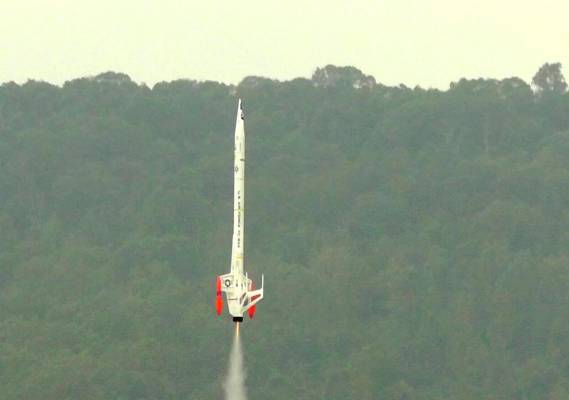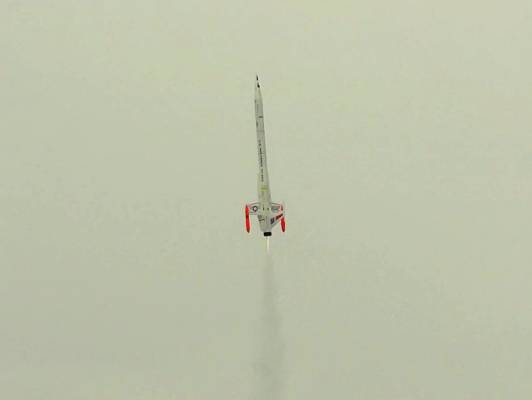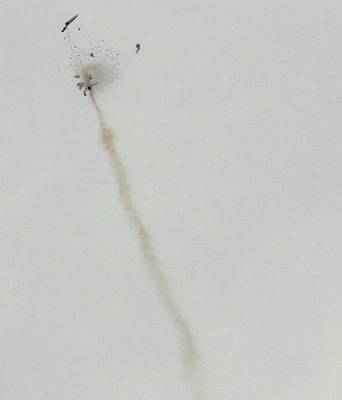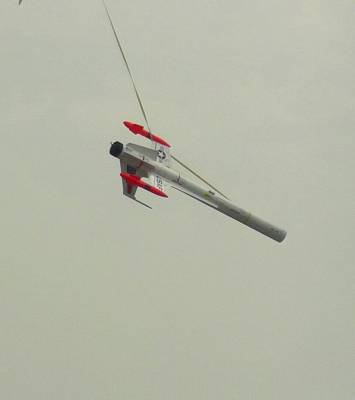The Interceptor: This rocket kit is the new release of the Estes Interceptor. It flies on 18mm B and C motors. This kit was modified with an ejection-gas baffle and Kevlar shock cord mount, and an Iris Altimeter Payload Section. After 6 months, it's finally ready. Construction went well, but painting using bargain-price Home Depot paint resulted in "orange peel" finish, which had to be sanded off - TWICE, and re-applied. The paint then reacted with the primer (SAME BRAND!!) and crinkled and cracked the finish. Re-sanded again and then used the expensive but acceptable Testors paint for $5 per 3 oz can. Clear-coat, decals, then 3 more clear-coats and finally it's done. With the generous glue, extra paint and the added electronics bay, she weighs in at 164.5 grams (5.6 oz.) and is 3.2" longer than stock. I'll plan to use the shorter ejection motors than recommended, just in case it's a little too heavy. Typically for me, this model only passed a string-stability test after I added 17 grams of nose-weight on the base of the nosecone. (Am I doing them wrong??) We'll see how well she flies, but she sure is a pretty gal!
We DID see how she flies, and it wasn't pretty. This model is grossly overweight. The baffle (10 grams?), payload section (19 grams), and the heavy nose-weight (17 grams) makes this too much for even a C6-3 motor. I'm going to send this up on a D10 just to see how well she can fly. Then I'm going to have to take out that nose-weight and see if it's stable enough for flight, I expect it to fly better that way. If it does not and it is destroyed, at least I'll have that one good D-flight to remember.
With the Apogee (Aerotek) D10 motor, this model has flown This rocket has flown higher than the St. Louis Gateway Arch, the Singer building in NY, NY, and the Chicago Temple Building.
I won't want to fly this on a regular basis using the $10 apogee motors though, so instead I hatched a plan to add two small A10-3T boosters on the back, for a total impulse with a C6 motor of 26. The parts for the "solid-rocket-boosters" were obtained from two Estes 220 Swift rockets. I'm waiting to see how well it will fly without the nose-weight before proceeding with this plan. It would be my first cluster rocket project.
| Flight Date: | 2013-08-31 |
| Rocket Name: | Interceptor |
| Kit Name: | Estes - Interceptor {Kit} (1250) [2008-2011,2019-] |
| Flyer's Name: | Rich DeAngelis |
| Motors: | C6-3 |
| Launch Site: | Fort Indiantown Gap, PA |
| Actual Altitude: | 168 Feet |
I have removed all noseweights from this model, making it over 8 grams lighter. Now I'll see if it can fly well with a C6, though previous flights with noseweights were very disappointing. I am also using a lightweight 19 inch parachute.
The motor started burning, accelerating this model at 5.2 Gs off the rod. That was the best so far. As the motor burned for 1.9 seconds, it averaged 1.2 Gs, as normal. This time it reached 49 mph (slightly less), but it continued its vertical ascent.
After coasting for 2.3 seconds it hit 155 feet when the ejection fired. It still continued up another 25 feet to reach an apogee of 180 feet - a new record for C6 power! It was unfortunate that the delay was terribly short.
The big 19 inch 'chute opened up and the rocket returned at 6 mph for a soft grass landing...right by my tailgate! The extra long shock cord was wrapped around the wing pod, so the body came down sideways. I didn't even have to carry it back to prep it for another flight! Very successful test flight.
| Stage | Motor(s) |
|---|---|
| 1 | Estes C6-3 |
 |
 |



